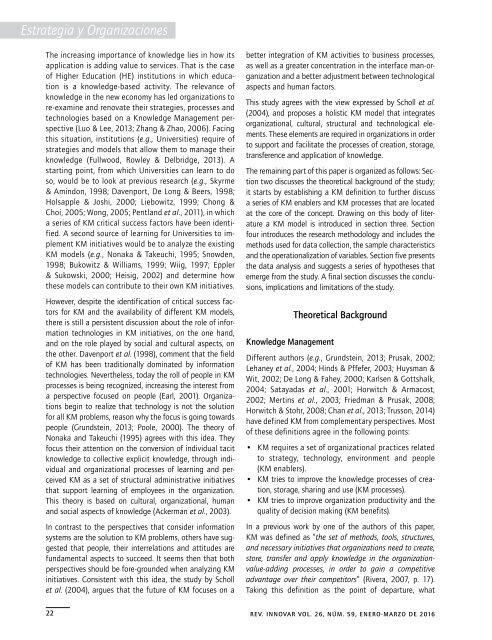Enero-marzo
v26n59
v26n59
Create successful ePaper yourself
Turn your PDF publications into a flip-book with our unique Google optimized e-Paper software.
Estrategia y Organizaciones<br />
The increasing importance of knowledge lies in how its<br />
application is adding value to services. That is the case<br />
of Higher Education (HE) institutions in which education<br />
is a knowledge-based activity. The relevance of<br />
knowledge in the new economy has led organizations to<br />
re-examine and renovate their strategies, processes and<br />
technologies based on a Knowledge Management perspective<br />
(Luo & Lee, 2013; Zhang & Zhao, 2006). Facing<br />
this situation, institutions (e.g., Universities) require of<br />
strategies and models that allow them to manage their<br />
knowledge (Fullwood, Rowley & Delbridge, 2013). A<br />
starting point, from which Universities can learn to do<br />
so, would be to look at previous research (e.g., Skyrme<br />
& Amindon, 1998; Davenport, De Long & Beers, 1998;<br />
Holsapple & Joshi, 2000; Liebowitz, 1999; Chong &<br />
Choi, 2005; Wong, 2005; Pentland et al., 2011), in which<br />
a series of KM critical success factors have been identified.<br />
A second source of learning for Universities to implement<br />
KM initiatives would be to analyze the existing<br />
KM models (e.g., Nonaka & Takeuchi, 1995; Snowden,<br />
1998; Bukowitz & Williams, 1999; Wiig, 1997; Eppler<br />
& Sukowski, 2000; Heisig, 2002) and determine how<br />
these models can contribute to their own KM initiatives.<br />
However, despite the identification of critical success factors<br />
for KM and the availability of different KM models,<br />
there is still a persistent discussion about the role of information<br />
technologies in KM initiatives, on the one hand,<br />
and on the role played by social and cultural aspects, on<br />
the other. Davenport et al. (1998), comment that the field<br />
of KM has been traditionally dominated by information<br />
technologies. Nevertheless, today the roll of people in KM<br />
processes is being recognized, increasing the interest from<br />
a perspective focused on people (Earl, 2001). Organizations<br />
begin to realize that technology is not the solution<br />
for all KM problems, reason why the focus is going towards<br />
people (Grundstein, 2013; Poole, 2000). The theory of<br />
Nonaka and Takeuchi (1995) agrees with this idea. They<br />
focus their attention on the conversion of individual tacit<br />
knowledge to collective explicit knowledge, through individual<br />
and organizational processes of learning and perceived<br />
KM as a set of structural administrative initiatives<br />
that support learning of employees in the organization.<br />
This theory is based on cultural, organizational, human<br />
and social aspects of knowledge (Ackerman et al., 2003).<br />
In contrast to the perspectives that consider information<br />
systems are the solution to KM problems, others have suggested<br />
that people, their interrelations and attitudes are<br />
fundamental aspects to succeed. It seems then that both<br />
perspectives should be fore-grounded when analyzing KM<br />
initiatives. Consistent with this idea, the study by Scholl<br />
et al. (2004), argues that the future of KM focuses on a<br />
better integration of KM activities to business processes,<br />
as well as a greater concentration in the interface man-organization<br />
and a better adjustment between technological<br />
aspects and human factors.<br />
This study agrees with the view expressed by Scholl et al.<br />
(2004), and proposes a holistic KM model that integrates<br />
organizational, cultural, structural and technological elements.<br />
These elements are required in organizations in order<br />
to support and facilitate the processes of creation, storage,<br />
transference and application of knowledge.<br />
The remaining part of this paper is organized as follows: Section<br />
two discusses the theoretical background of the study;<br />
it starts by establishing a KM definition to further discuss<br />
a series of KM enablers and KM processes that are located<br />
at the core of the concept. Drawing on this body of literature<br />
a KM model is introduced in section three. Section<br />
four introduces the research methodology and includes the<br />
methods used for data collection, the sample characteristics<br />
and the operationalization of variables. Section five presents<br />
the data analysis and suggests a series of hypotheses that<br />
emerge from the study. A final section discusses the conclusions,<br />
implications and limitations of the study.<br />
Knowledge Management<br />
Theoretical Background<br />
Different authors (e.g., Grundstein, 2013; Prusak, 2002;<br />
Lehaney et al., 2004; Hinds & Pffefer, 2003; Huysman &<br />
Wit, 2002; De Long & Fahey, 2000; Karlsen & Gottshalk,<br />
2004; Satayadas et al., 2001; Horwitch & Armacost,<br />
2002; Mertins et al., 2003; Friedman & Prusak, 2008;<br />
Horwitch & Stohr, 2008; Chan et al., 2013; Trusson, 2014)<br />
have defined KM from complementary perspectives. Most<br />
of these definitions agree in the following points:<br />
• KM requires a set of organizational practices related<br />
to strategy, technology, environment and people<br />
(KM enablers).<br />
• KM tries to improve the knowledge processes of creation,<br />
storage, sharing and use (KM processes).<br />
• KM tries to improve organization productivity and the<br />
quality of decision making (KM benefits).<br />
In a previous work by one of the authors of this paper,<br />
KM was defined as “the set of methods, tools, structures,<br />
and necessary initiatives that organizations need to create,<br />
store, transfer and apply knowledge in the organizationvalue-adding<br />
processes, in order to gain a competitive<br />
advantage over their competitors” (Rivera, 2007, p. 17).<br />
Taking this definition as the point of departure, what<br />
22 REV. INNOVAR VOL. 26, NÚM. 59, ENERO-MARZO DE 2016


